Insect eating plants, commonly referred to as Insectivorous or carnivorous plants are plants that derive some or most of their nutrients from trapping and consuming insects, protozoans and other small arthropods. Carnivorous plants still generate some of their energy from photosynthesis. The insectivorous plants digest the prey chemically using enzymes and bacteria. The end products of the chemical breakdown are absorbed by the plants to help them survive under unfavourable conditions. Carnivorous plants consume insects to supplement the nutrients they absorb from soil.
Insectivorous plants (often called carnivorous) carry out photosynthesis and colonise environments which lack nitrogen and minerals, and where competition with other plants is minimal ( i.e swamps and bogs, in nutrient-poor bodies of water or on thin tropical soils). They integrate the deficiency of nutrients by using organic matter obtained from insects and small animals. They have therefore deeply modified the shape of their leaves, which are used to appeal, capture, and digest their prey and absorb the products of digestion. Their leaves are both active and passive traps, i.e., they move according to variations in the turgor of their cells.
Depending on the type of insect the plant consumes, it produces a nectar formulated to appeal to its victims. Some pitcher plants, for example, trap flies. These insects dine on carrion, so the plant emits a foul-smelling nectar with a scent that resembles rotting meat. Other carnivorous plants seek pollinating flies or small bees, so they emit sweet-smelling nectars to lure these types of insects.
Characteristics of Carnivorous Plants
- They are found in the places, where there is a lack of some nutrients, especially nitrogen. They entrap insects and digest them to suffice their nitrogen requirement.
- The carnivorous plants are colourful and shiny in appearance to attract insects. They often have nectars and a pleasant odour to attract insects.
- Depending on the type of insect the plant consumes, it produces a nectar formulated to appeal to its victims.
- Many carnivorous plants have special or modified plant parts to trap insects. The mouth of the insectivorous plants has hair-lined lined edges that snap or shut as soon as the insect touches the hair, thereby, trapping the insects. Some of the plants’ stalks are covered with sticky mucus-like substances where the insect sticks and cannot move.
- Some carnivorous plants secrete digestive enzymes that dissolve the insect for absorption. Others have bacteria or mites in their digestive tract that mimic the functions of the human digestive tract. They digest the prey for absorption by the plants.
- The carnivorous plants are found mostly in wet, damp, humid, and acidic soil, that is deficient in nutrients, such as swamps, bogs, wetlands, coastal plains, etc. They are found in the wet regions of North America, Australia, and tropical regions.
- Carnivorous plants also engage in photosynthesis to manufacture their own food supplies, the same as their noncarnivorous cousins. Insects only provide vital nutrients lacking in soil, not the sugars required for energy.
- These unusual plants live on every continent except Antarctica.
- The most common prey for carnivorous plants are small insects such as gnats, flies, bees, moths, beetles, and ants.
Common Traps Found In Carnivorous or Insectivorous Plants
The leaves of the plants are modified in the form of traps. The trapping mechanisms are designated as active or passive depending upon whether they move to capture the prey or not. The different types of traps found in carnivorous plants are mentioned below:
- Pitfall Traps: These are found in a pitcher plant. They comprise of a hollow leaf with a lid, filled with liquid to digest the prey.
- Snap Traps: These type of traps are found in Venus flytrap. They shut their leaves rapidly as the prey touches the trigger hair.
- Bladderwort Traps: These are commonly found in Utricularia. They use a partial vacuum to suck the small organisms.
- Flypaper Traps: These traps are sticky and adhesive. The leaves are covered in stalked glands that secrete sticky mucilage.
- Lobster-pot Traps: These are found in corkscrew plants. They possess downward-pointing hair that pushes the prey deep inside the trap.
Types of Insectivorous (Carnivorous) Plants
The more than 600 known species of carnivorous plants constitute a very diverse group, in some cases having little more in common than their carnivorous habit. Here are some of the know carnivorous plants:
- Pitcher Plant
- Venus Flytrap
- Cobra Lily
- Butterwort
- Monkey Cup
- Sundews
- Bladderworts
- Dewy Pine
- Waterwheel Plant
- Corkscrew plant (Genlisea)
- Byblis
- Roridula
- Triantha
- Powdery strap airplant
- Brocchinia reducta
- Philcoxia
Pitcher Plant
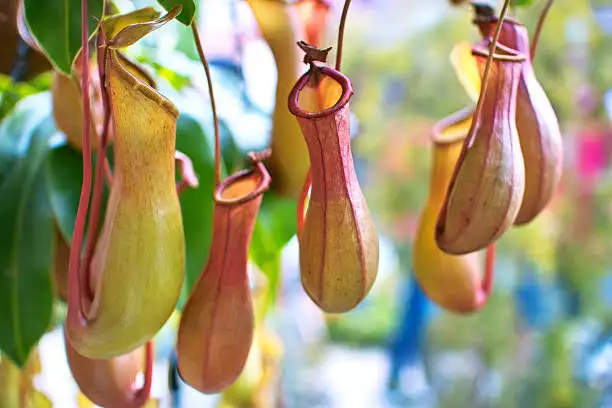
Nepenthes is also known as pitcher plant. This is found generally in Asia, Sri Lanka, and Australia. In their natural environment, insects crawl inside of the plant’s funnel-shaped leaves in an attempt to reach nectar secreted by a narrow section near the leaves’ base. Each leaf is lined with hundreds of slippery, downward pointing hairs that prevent escape and force the insect to drop into a pool of digestive juices near the leaf’s base. Once the insect is trapped and produces movement in the plant, the plant starts secreting the digestive liquid. The organism is digested and the nutrients are absorbed.
Venus flytrap

The Venus flytrap’s (Dionaea muscipula) circular green leaves have fine hairs along their edges and are divided into two lobes that hinge at the base. If an insect touches two or more of the hairs at the same time the leaf snaps shut, the insect is trapped and digestive glands secrete enzymes that slowly digest it. The colors are frequently shades of green, yellow and red, with some varieties having a multicolor appearance.
Cobra lily

Cobra lilies (Darlingtonia californica) attract their prey by emitting a sweet smell from inside a hollow leaf shaped like the curled head of a cobra. A split-leaf appendage resembling a cobra’s tongue hangs down from the leaf opening. Inside the leaf the insect is confused by light penetrating the top and sides, and it cannot find its way out. It falls into a digestive acid pool at the base of the leaf and is digested by the plant.
Butterworts
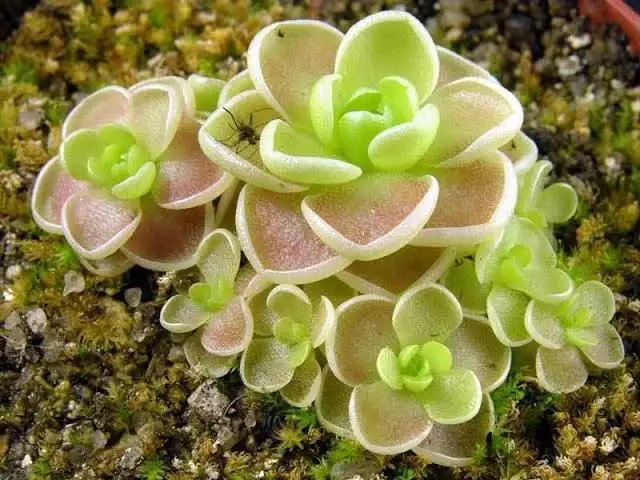
Butterworts (Pinguicula spp.) are small plants with curled-edge leaves a few inches in diameter. The leaves grow in a pinwheel pattern at the base of fragile pink, white or purple flowers balanced on a slim stem. Insects attracted to the plant become stuck in a sticky, saplike fluid coating the leaves. The fluid contains enzymes that slowly digest the insect and provide nutrients to the plant.
Corkscrew plant
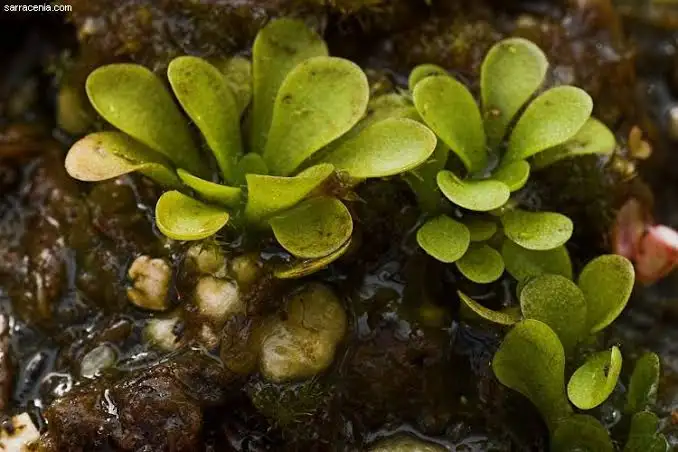
It is also referred to as Genlisea plant and is commonly found in the wet terrestrial to the semi-aquatic environment. It contains the Lobster pot trap that has small hair lined at the entrance. It is made up of two types of leaves- the underground leaves that absorb water from the soil and anchor the plant firmly in the soil. These underground leaves form hollow tubes. With the aid of water flow, the insects enter these tubes but cannot come out.
Monkey Cup
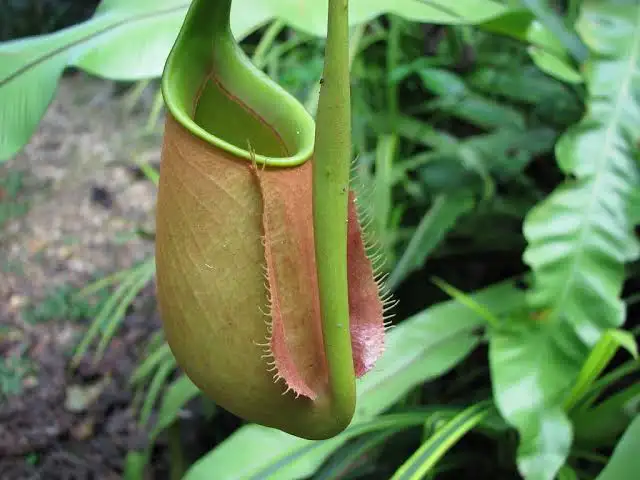
The nickname monkey cup comes from the observation that monkeys will drink the fluid out of the cup-like traps occasionally in the wild. The prey is lured to the traps on the monkey cup by a combination of nectar, odor of sweetness or decay, and occasionally by the color red. The trap has steep sides and a relatively narrow rim that often angles downward into the cup. The insect or other small creature perches on the rim to drink nectar and often can’t maintain footing. It slips into the trap, and is unable to escape.In many species, the steep sides are covered in a flaky, waxy substance, or in downward pointing hairs that add to the difficulty.
Sundews

Drosera, which is commonly known as the sundews, is one of the largest genera of carnivorous plants, with at least 194 species. Their green leaves come in a variety of shapes depending on the species, including narrow, oval, or round. The leaves are covered with glands with tiny stalks (sometimes referred to as “tentacles”) that secrete mucus which captures insects by luring them with scent. The insects are then trapped in the sticky surface of the leaves where they are digested. The leaf curls up to digest its prey and then unfurls to rest the trap again. This process takes between four and six days.
Bladderwort
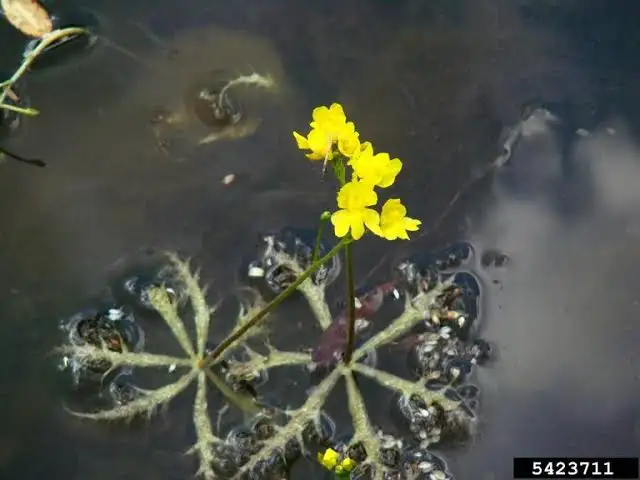
Bladderwort are rootless aquatic plants commonly found in shallow ponds, lakes, ditches, marshes and slow-moving streams and rivers. They are unique in that, the underwater leaves bear small oval “bladders” that trap and digest small aquatic creatures. Bladderworts trap small organisms in their tiny bladders which have a trap door that is triggered by hairs on the door. When prey comes in contact with the hairs the door opens in a millisecond, sucking the animal in, and closing in about 2.5 milliseconds. The primary food is water flies and mosquito larvae.
Dewy Pine
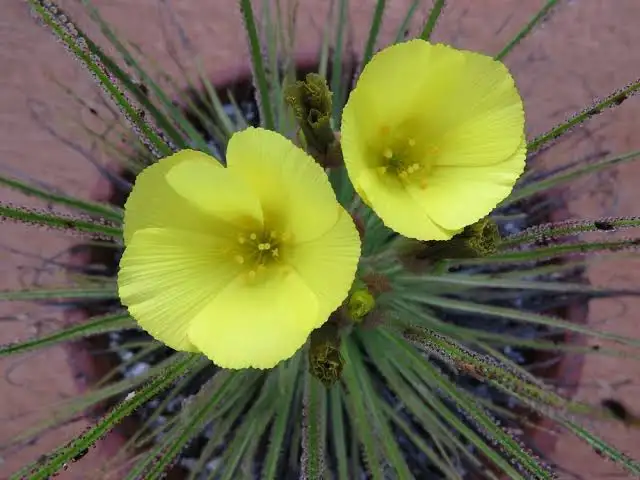
The Dewy Pine is a species of carnivorous plant known by the scientific name Drosophyllum lusitanicum. The Dewy Pine’s carnivorous leaves look like pine needles slathered in tiny drops of sweet-smelling dew. As old carnivorous leaves die back, they produce a branching stem that looks like the woody stem of a small tree. The Dewy Pine is a plant that has interested scientists and botanists for a while. The unique thing about this plant is that out of all the rest of the carnivorous plants in the world such as the Pitcher Plant, Venus Fly Trap, etc., this meat eater is the most successful in trapping plants when it comes to quantity. The plant is able to capture several bugs on each of its leaf-stalked clammy glands. The prey count is so numerous that the plant has a passive primitive adhesive trap, that is less aggressive.
Waterwheel Plant
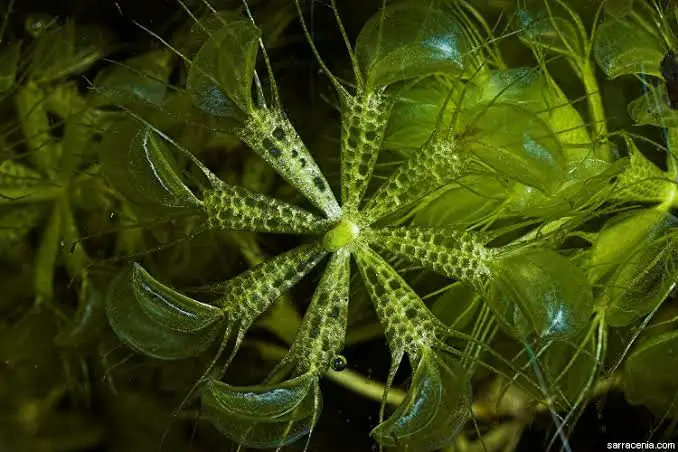
The waterwheel plant is a submerged aquatic plant. Its leaves are in whorls and the leaf tips are fitted with scoop-like traps. It is a carnivorous plant that catches animal prey through an active trap mechanism – traps snap shut when triggered by prey. Traps number up to 200 per plant and researchers estimate that up to 80% of the traps may contain prey at any given time.The waterwheel plant first discovered by botanists in 1696 and studied by the likes of Charles Darwin, and is the only species to have evolved snap-trap carnivory under water. It takes just 100 milliseconds for the snapping leaves to close upon small, unsuspecting aquatic invertebrates such as mosquito larvae.
Byblis
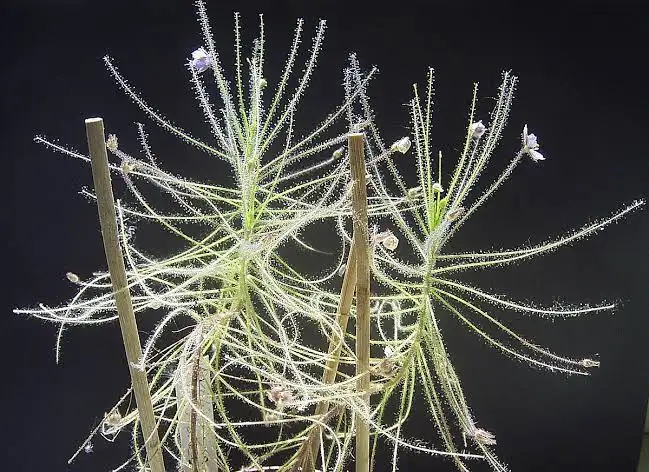
Byblis is a small genus of carnivorous plants, sometimes termed the rainbow plants for the attractive appearance of their mucilage-covered leaves in bright sunshine. The leaves of all species are round in cross section and highly elongated, tapering at the end. The surface of the leaves is densely studded with glandular hairs which secrete a mucilaginous substance from their tip. These serve to attract small insects, which upon touching the sticky secretions are ensnared. Unless they are strong enough to escape, the insect prey either die of exhaustion or asphyxiate as the mucilage envelops them and clogs their spiracles. All species of the genus form upright growth supported by a weak, fibrous root system.
Roridula

Roridula is a genus of evergreen, insect-trapping shrubs. It has thin, woody, shyly branching, upright, initially brown, later grey stems, with lance- to awl-shaped leaves crowded at their tips. The star-symmetrical flowers consist from the outside in of five, green or reddish, free sepals, alternating with five white, pink or purple, free petals. Further to the middle and opposite the sepals are five stamens with the anthers initially kinked down. These suddenly flip up if the nectar-containing swelling at its base is being touched.
Triantha occidentalis

Triantha occidentalis can be found in the wetlands, bogs, marshes, wet meadows and river shores. In the summer, it shoots up tall flowering stems coated with sticky hairs that trap small insects like gnats and midges. Triantha is unique among carnivorous plants in capturing prey, its glandular hairs capture only small insects, unlike the large bees and butterflies that act as pollinators. Glandular hairs on flowering stems secrete phosphatase, as seen in all carnivorous plants that directly digest prey.
Powdery strap airplant
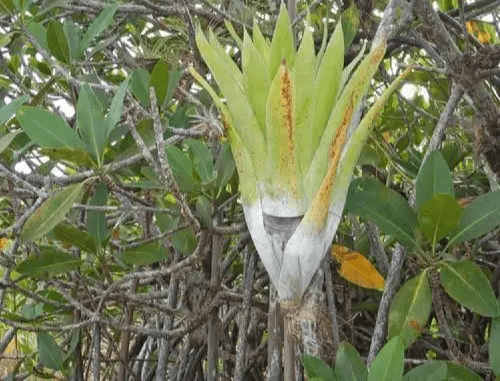
Catopsis berteroniana commonly known as the powdery strap airplant or the lantern of the forest, is an epiphytic bromeliad, carnivorous plant, that grows high up on tree branches for support, and enjoys living in sunny areas where there is very little falling leaf litter. The leaves are covered with a white, chalky powder, which helps to reflect ultraviolet light, in effect rendering the plant invisible to insects. Insects fly into the branches, collide with the leaves and fall into the tank of rainwater collected in the vase-like leaf rosette. If the insects do try to climb back out, they slip on the chalky, white substance and back into the water where they drown. It is thought that glands on the leaves absorb nutrients from these drowned insects.
Brocchinia reducta
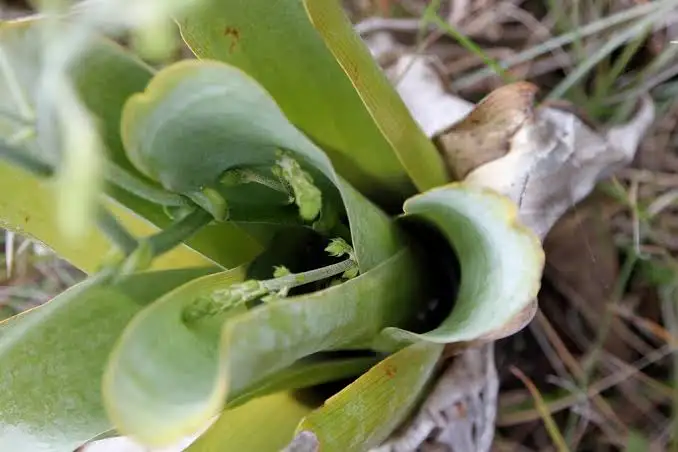
Brocchinia reducta is one of a few carnivorous bromeliad; and like many other bromeliads, forms a water-storing cup with its tightly overlapping leaves. Its erect leaves form a yellowish cylinder with a cuticular lubricant on its inner surface, impound fluid that emits a nectarlike fragrance, and bear trichomes capable of absorbing amino acids from this fluid in which numerous insects, mainly ants and small insects drown.
Philcoxia
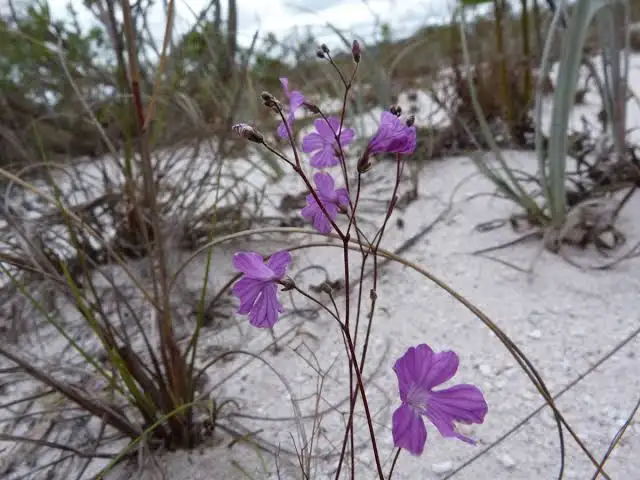
Philcoxia is the most recent carnivorous plant genus to have been discovered. Members of the genus are small perennial or annual herbs that reside in oases of deep white sand surrounded by the typical vegetation. They are no more than 26 cm tall with 5-10 leaves. Zigzag-shaped racemes are produced from upright stems and account for the height of the species. These inflorescences are leafless and produce pale blue to lilac flowers. The flowers possess monothecous, glabrous anthers, which are unusual in the family. The upper surface of the leaves are covered with stalked capitate glands that are also seen in many carnivorous plant genera.